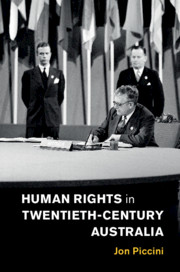Book contents
- Human Rights in Twentieth-Century Australia
- Human Rights in History
- Human Rights in Twentieth-Century Australia
- Copyright page
- Dedication
- Contents
- Acknowledgements
- Introduction: Bereft of Words
- 1 Inventing Rights
- 2 Cold War Rights
- 3 Experimental Rights
- 4 Whose Rights?
- 5 Implementing Rights
- Epilogue: Cascade or Trickle?
- Index
4 - Whose Rights?
Published online by Cambridge University Press: 20 September 2019
- Human Rights in Twentieth-Century Australia
- Human Rights in History
- Human Rights in Twentieth-Century Australia
- Copyright page
- Dedication
- Contents
- Acknowledgements
- Introduction: Bereft of Words
- 1 Inventing Rights
- 2 Cold War Rights
- 3 Experimental Rights
- 4 Whose Rights?
- 5 Implementing Rights
- Epilogue: Cascade or Trickle?
- Index
Summary
More Australians were talking about a wider array of rights than ever before in the 1970s. A new generation of militant Indigenous activists and young women saw the need for new or reimagined conceptions beyond inherited gradualist, equalitarian visions of political change. Indigenous radicals, buoyed and subsequently disappointed by the remarkable referendum victory of May 1967, were soon petitioning the UN over structural and endemic economic and cultural rights infringements. Reflecting anti-colonial rhetoric at the United Nations, activists placed the need for the right to restitution for the wrongs of colonialism at the centre of their human rights agenda. Women’s liberationists, on the other hand, rejected calls for a new international order that merely replicated divisions between the private and public, the breadwinner and homemaker. Not only would this potentially weaken gains by Western feminists, but merely replicating the demands of underdeveloped states might dramatically limit the rights of women in developing nations. The so-called Right to Life movement sought to appropriate the concept of “human” at the same time, pushing its definition beyond birth to the time of conception. As rights became more a focus of public discussion, battle lines were also being drawn as to what rights were and who could claim them.
Keywords
- Type
- Chapter
- Information
- Human Rights in Twentieth-Century Australia , pp. 119 - 152Publisher: Cambridge University PressPrint publication year: 2019



